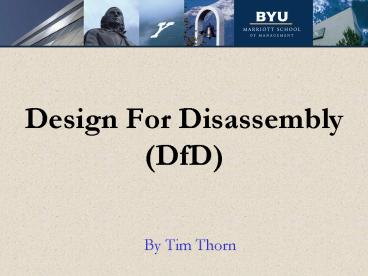Design For Disassembly DfD - PowerPoint PPT Presentation
1 / 18
Title:
Design For Disassembly DfD
Description:
End-of-life (EOL) objectives such as product reuse, remanufacture, and recycling ... Remanufacture. Recycling. Types of Disassembly. Destructive disassembly ... – PowerPoint PPT presentation
Number of Views:676
Avg rating:3.0/5.0
Title: Design For Disassembly DfD
1
Design For Disassembly (DfD)
- By Tim Thorn
2
The Agenda
- What is Design for Disassembly (DfD)?
- Brainstorming exercise
- Explanation
- How DfD works?
- An Example of DfD
- A brief exercise
- Summary
- Readings
3
Design For Disassembly
- Definition The use of assembly methods and
configurations that allow for cost-effective
separation and recovery of reusable components
and materials.
4
Brainstorming Exercise
- How can Design for disassembly be applied to our
organization to increase environmental awareness
and cut costs?
5
Further Information about DfD
6
Reasons for Disassembly
- Enable maintenance
- Enhance serviceability
- End-of-life (EOL) objectives such as product
reuse, remanufacture, and recycling
7
End-Of-Life Objectives
- Most important reason to disassemble
- Component reuse
- Remanufacture
- Recycling
8
Types of Disassembly
- Destructive disassembly
- Reverse Disassembly
- Two types of reverse disassembly
- Total
- Selective
9
Cost-Savings with Disassembly
- Better selection of materials
- More specific identification of component
materials - Assembly methods that provide for more efficient
and possibly automated disassembly
10
Benefits of DfD
- Components which are of good quality can be
refurbished or reused. - Metallic parts can be separated easily into
categories which increases their recycling value.
- Disassembled plastic parts can be easily removed
and recycled. - Parts made from other material such as glass or
hazardous material can easily be separated and
reprocessed.
11
So how does Disassembly work?
- Product is reacquired
- Product taken to special DfD facilities
- Each component of the product is taken off
- The components are sorted
- Then reused, recycled and refurbished
12
How can products be designed more effectively to
aid disassembly?
- Provide ready access to parts, fasteners, etc. to
support disassembly. - Design modular products to enable modules to be
disassembled for service or re-use. - Minimize weight of individual parts and modules
- Crow Kenneth. http//www.npd-solutions.com/dfe.htm
l - Crow Kenneth. http//www.npd-solutions.com/dfe.htm
l
13
Effective Design (Cont.)
- Use joining and fastening techniques to
facilitate disassembly (e.g., fasteners instead
of adhesives) - Minimize fragile parts and leads to enable re-use
and re-assembly. - Use connectors instead of hard-wired connections.
- Design to enable use of common hand tools for
disassembly. - Crow Kenneth. http//www.npd-solutions.com/dfe.h
tml
14
What industries use DfD?
- Construction
- Technology
- Furniture Manufacturing
- Electronic Manufacturing
- Automobile Manufacturing
15
Real world application
- Cell Phone Manufactures
- Initially too costly to disassemble
- Use of DfD
- Phones will soon take seconds to disassemble
16
Exercise
- What is Desgin for Disassembly?
- Why do we use DfD?
- What can be designed more effectively to aid in
disassembly? - What industries use DfD?
17
Summary
- By designing products that are easy to
disassemble we can conserve natural resources,
and if applied correctly can cut costs.
18
Readings List
- Billatos, S.B. 1997, Green Technology and Design
for the Enviroment. - Desai, Anoop. Mital,Anil Journal of Manufacturing
Technology Management 2005, Vol. 16 Issue 7,
p712-732, 21p - Dowie-Bhamra, Tracy. University of Manchester
http//www.co-design.co.uk/design.htm - Jana, Reena. Business Week Online Can Design
Change the World? 10/26/2006 - Crow, Kenneth. http//www.npd-solutions.com/dfe.ht
ml































